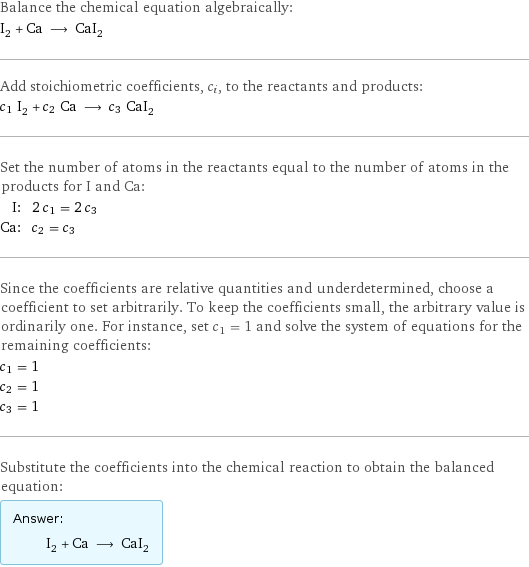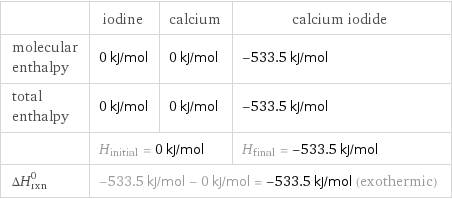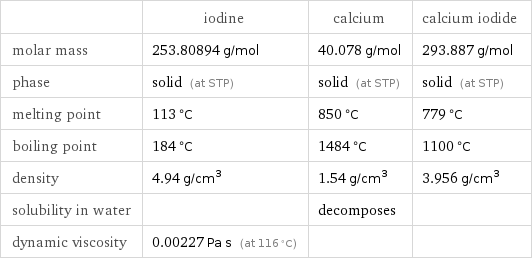Input interpretation

I_2 iodine + Ca calcium ⟶ CaI_2 calcium iodide
Balanced equation

Balance the chemical equation algebraically: I_2 + Ca ⟶ CaI_2 Add stoichiometric coefficients, c_i, to the reactants and products: c_1 I_2 + c_2 Ca ⟶ c_3 CaI_2 Set the number of atoms in the reactants equal to the number of atoms in the products for I and Ca: I: | 2 c_1 = 2 c_3 Ca: | c_2 = c_3 Since the coefficients are relative quantities and underdetermined, choose a coefficient to set arbitrarily. To keep the coefficients small, the arbitrary value is ordinarily one. For instance, set c_1 = 1 and solve the system of equations for the remaining coefficients: c_1 = 1 c_2 = 1 c_3 = 1 Substitute the coefficients into the chemical reaction to obtain the balanced equation: Answer: | | I_2 + Ca ⟶ CaI_2
Structures

+ ⟶
Names

iodine + calcium ⟶ calcium iodide
Reaction thermodynamics
Enthalpy

| iodine | calcium | calcium iodide molecular enthalpy | 0 kJ/mol | 0 kJ/mol | -533.5 kJ/mol total enthalpy | 0 kJ/mol | 0 kJ/mol | -533.5 kJ/mol | H_initial = 0 kJ/mol | | H_final = -533.5 kJ/mol ΔH_rxn^0 | -533.5 kJ/mol - 0 kJ/mol = -533.5 kJ/mol (exothermic) | |
Equilibrium constant
![Construct the equilibrium constant, K, expression for: I_2 + Ca ⟶ CaI_2 Plan: • Balance the chemical equation. • Determine the stoichiometric numbers. • Assemble the activity expression for each chemical species. • Use the activity expressions to build the equilibrium constant expression. Write the balanced chemical equation: I_2 + Ca ⟶ CaI_2 Assign stoichiometric numbers, ν_i, using the stoichiometric coefficients, c_i, from the balanced chemical equation in the following manner: ν_i = -c_i for reactants and ν_i = c_i for products: chemical species | c_i | ν_i I_2 | 1 | -1 Ca | 1 | -1 CaI_2 | 1 | 1 Assemble the activity expressions accounting for the state of matter and ν_i: chemical species | c_i | ν_i | activity expression I_2 | 1 | -1 | ([I2])^(-1) Ca | 1 | -1 | ([Ca])^(-1) CaI_2 | 1 | 1 | [CaI2] The equilibrium constant symbol in the concentration basis is: K_c Mulitply the activity expressions to arrive at the K_c expression: Answer: | | K_c = ([I2])^(-1) ([Ca])^(-1) [CaI2] = ([CaI2])/([I2] [Ca])](../image_source/1ec26a182c88826dedb1eee4fe6d6d94.png)
Construct the equilibrium constant, K, expression for: I_2 + Ca ⟶ CaI_2 Plan: • Balance the chemical equation. • Determine the stoichiometric numbers. • Assemble the activity expression for each chemical species. • Use the activity expressions to build the equilibrium constant expression. Write the balanced chemical equation: I_2 + Ca ⟶ CaI_2 Assign stoichiometric numbers, ν_i, using the stoichiometric coefficients, c_i, from the balanced chemical equation in the following manner: ν_i = -c_i for reactants and ν_i = c_i for products: chemical species | c_i | ν_i I_2 | 1 | -1 Ca | 1 | -1 CaI_2 | 1 | 1 Assemble the activity expressions accounting for the state of matter and ν_i: chemical species | c_i | ν_i | activity expression I_2 | 1 | -1 | ([I2])^(-1) Ca | 1 | -1 | ([Ca])^(-1) CaI_2 | 1 | 1 | [CaI2] The equilibrium constant symbol in the concentration basis is: K_c Mulitply the activity expressions to arrive at the K_c expression: Answer: | | K_c = ([I2])^(-1) ([Ca])^(-1) [CaI2] = ([CaI2])/([I2] [Ca])
Rate of reaction
![Construct the rate of reaction expression for: I_2 + Ca ⟶ CaI_2 Plan: • Balance the chemical equation. • Determine the stoichiometric numbers. • Assemble the rate term for each chemical species. • Write the rate of reaction expression. Write the balanced chemical equation: I_2 + Ca ⟶ CaI_2 Assign stoichiometric numbers, ν_i, using the stoichiometric coefficients, c_i, from the balanced chemical equation in the following manner: ν_i = -c_i for reactants and ν_i = c_i for products: chemical species | c_i | ν_i I_2 | 1 | -1 Ca | 1 | -1 CaI_2 | 1 | 1 The rate term for each chemical species, B_i, is 1/ν_i(Δ[B_i])/(Δt) where [B_i] is the amount concentration and t is time: chemical species | c_i | ν_i | rate term I_2 | 1 | -1 | -(Δ[I2])/(Δt) Ca | 1 | -1 | -(Δ[Ca])/(Δt) CaI_2 | 1 | 1 | (Δ[CaI2])/(Δt) (for infinitesimal rate of change, replace Δ with d) Set the rate terms equal to each other to arrive at the rate expression: Answer: | | rate = -(Δ[I2])/(Δt) = -(Δ[Ca])/(Δt) = (Δ[CaI2])/(Δt) (assuming constant volume and no accumulation of intermediates or side products)](../image_source/3f3050cc98db5257889f1f38c4c48ae3.png)
Construct the rate of reaction expression for: I_2 + Ca ⟶ CaI_2 Plan: • Balance the chemical equation. • Determine the stoichiometric numbers. • Assemble the rate term for each chemical species. • Write the rate of reaction expression. Write the balanced chemical equation: I_2 + Ca ⟶ CaI_2 Assign stoichiometric numbers, ν_i, using the stoichiometric coefficients, c_i, from the balanced chemical equation in the following manner: ν_i = -c_i for reactants and ν_i = c_i for products: chemical species | c_i | ν_i I_2 | 1 | -1 Ca | 1 | -1 CaI_2 | 1 | 1 The rate term for each chemical species, B_i, is 1/ν_i(Δ[B_i])/(Δt) where [B_i] is the amount concentration and t is time: chemical species | c_i | ν_i | rate term I_2 | 1 | -1 | -(Δ[I2])/(Δt) Ca | 1 | -1 | -(Δ[Ca])/(Δt) CaI_2 | 1 | 1 | (Δ[CaI2])/(Δt) (for infinitesimal rate of change, replace Δ with d) Set the rate terms equal to each other to arrive at the rate expression: Answer: | | rate = -(Δ[I2])/(Δt) = -(Δ[Ca])/(Δt) = (Δ[CaI2])/(Δt) (assuming constant volume and no accumulation of intermediates or side products)
Chemical names and formulas

| iodine | calcium | calcium iodide formula | I_2 | Ca | CaI_2 name | iodine | calcium | calcium iodide IUPAC name | molecular iodine | calcium | calcium diiodide
Substance properties

| iodine | calcium | calcium iodide molar mass | 253.80894 g/mol | 40.078 g/mol | 293.887 g/mol phase | solid (at STP) | solid (at STP) | solid (at STP) melting point | 113 °C | 850 °C | 779 °C boiling point | 184 °C | 1484 °C | 1100 °C density | 4.94 g/cm^3 | 1.54 g/cm^3 | 3.956 g/cm^3 solubility in water | | decomposes | dynamic viscosity | 0.00227 Pa s (at 116 °C) | |
Units
